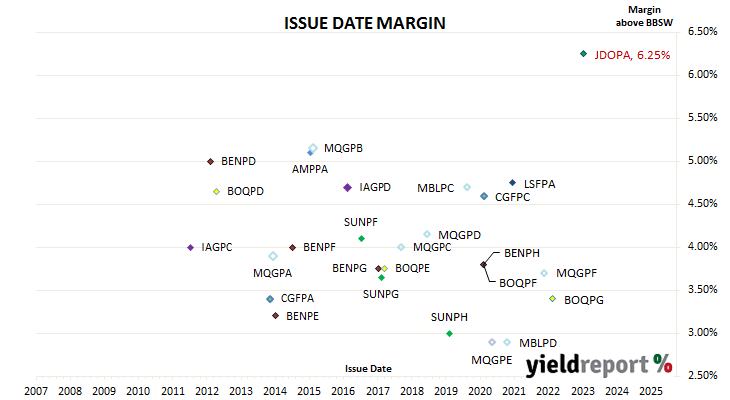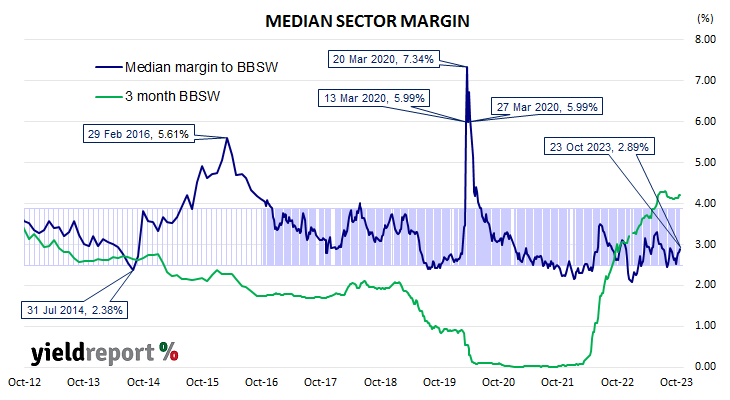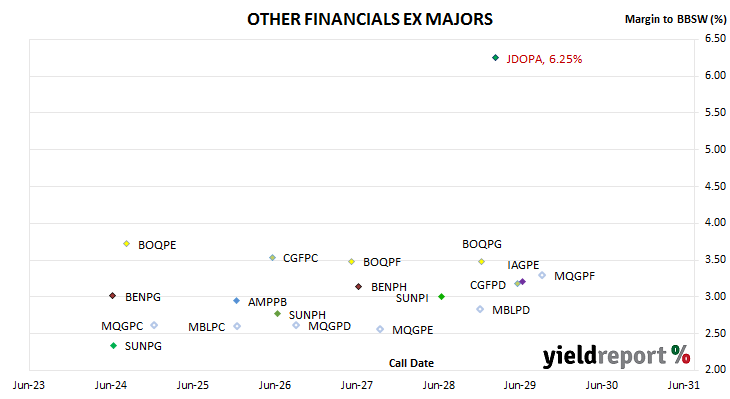Summary: Judo Capital to issue new hybrid security, JDOPA; expected to initially pay around 10.45% (annualised, including franking credits); likely issue margin 6.25%; well above current median sector margin; first call date in February 2029; trading expected to begin on 17 November 2023.
Judo Capital is the holding company for Judo Bank, an approved deposit-taking institution since April 2019. Judo Bank’s lending operations concentrate on small and medium-sized businesses while around two-thirds of its funding comes from term deposits. Its shares were listed on the ASX in October 2021. It now plans to add its first listed hybrid security.
Judo plans to raise $75 million via an issue of Capital Notes (code: JDOPA), with the ability to raise more or less than this amount. The new securities will be perpetual, convertible, subordinated, unsecured, redeemable notes and the proceeds will be used to “raise Additional Tier 1 Capital for Judo Bank, as part of Judo’s strategic plan to further develop and diversify its funding and capital sources…”
The new notes have some features in common with both equities and debt securities. Distributions are at the discretion of directors but they are calculated according to a set formula with reference to the $100 face value of the securities. In the event Judo were wound up, its hybrids would rank above ordinary shares but below ordinary debt securities and other liabilities. However, the existence of a “write-off” clause implies the hybrids would likely no longer exist should Judo find itself in this position.
The capital notes will have a distribution rate equivalent to 3-month BBSW plus a margin which lies in a range from 625bps to 650bps. The final margin will be determined by a “book build” and the result will be announced on 31 October 2023. A book build is a tender process managed by investment banks on behalf of the issuer in which investment institutions place bids for a set volume at a price/yield.
The chart above shows the history of issue margins of non-major bank hybrid securities over the last fifteen years or so, including the GFC period in 2008/2009. Judo’s likely margin is displayed at the lower bound of the indicative range.
Distributions will be non-cumulative, at the discretion of directors and paid quarterly in arrears. However, should a distribution not be paid, Judo cannot declare, determine to pay, or pay dividends on its ordinary shares until the next distribution payment date. It would also not be allowed to undertake any buy-back or capital reduction. Judo has not paid dividends on its ordinary shares so far.
At the prevailing level of interest rates and if the margin is at the lower end of the range, the new notes will initially pay around 10.45%* (annualised) inclusive of franking credits. *As interest rates change, specifically the bank bill swap rate, quarterly payments will also change.
The first call date is 16 February 2029. This is the first date at which Judo can exchange all or some of the securities in the absence of a “Loss Absorption Event”, “Non-Viability Trigger Event”, “Common Equity Trigger Event” or some other “event” as stated in the product disclosure statement.
The scheduled mandatory exchange date is 16 November 2031. Exchange, in the context of listed hybrids, may mean redeem, resell to a third party or convert into ordinary shares. Issue margins are generally set close to the margins of comparable hybrids already trading on the ASX. However, Judo is not really comparable to other issuers. Readers will see Judo’s likely issue margin is well above the band which captures the majority of median margin readings from 2011.
From late-2015 through to early 2017, hybrid margins blew out as doubts emerged over the sturdiness of a hybrid structure in an economic downturn. They gradually fell back over the following three years, drifting down to below the long-term channel (see above) just before the March 2020 spike. The median margin of hybrids currently listed on the ASX at the close of business on 23 October was 2.89%.
Prices for securities change as soon as trading begins, whether it is on an organised market such as the ASX or an over-the-counter (OTC) market. Other securities issued at different margins may have fallen (or risen) in price, which generally means their margins will have changed. The chart below shows the margins of non-major bank hybrid securities which trade on the ASX as at the close of business on 23 October 2023.
YieldReport has explained the meaning of “margin” in previous articles so for those readers who are not familiar with the term or who just want a refresher explanation, click here.
There will be an institutional offer and an offer1 to clients of joint lead managers, co-managers or syndicate brokers to the issue who may apply via the “broker firm” offer2. There will be no offer to the general public.
Trading on the ASX is expected to begin on 17 November 2023.
1 Must be an Australian resident.
2 Must be a “wholesale” investor or an investor who has received personal financial product advice from a licensed professional adviser to acquire Judo Capital Notes. Applications must be made through a syndicate broker.




